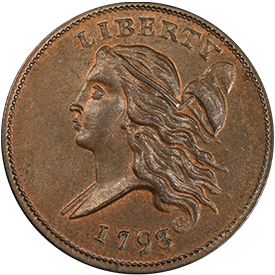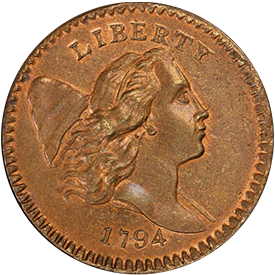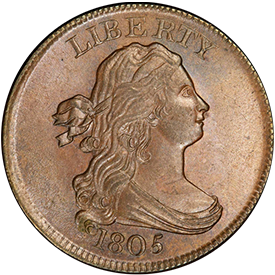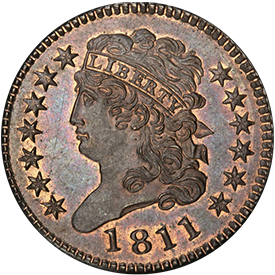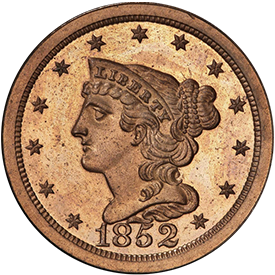Half cents, along with cents, were the first coins minted by the newly opened Philadelphia mint in the spring and early summer of 1793. Minted until 1857, they comprise one of the most interesting of all American numismatic series. Within this range are to be found many fascinating pieces – overdates, rarities, die errors, restrikes, and other delicacies for collectors.
Unlike large cents, which were minted continuously (with the exception of 1815) from 1793 through 1857, half cents were produced at sporadic intervals. The half cent series is therefore characterized by intermissions, the longest spanning the years from 1812 through 1824. Another interruption in circulation strikes lasted from 1836 though 1848, although Proofs were struck for collectors in 1836 and throughout the 1840s.
In most instances the designs of half cents followed those used on large cents, although often the half cents lagged behind. For example, the Draped Bust style was not used on the half cent denomination until 1800, although it saw service on large cents in 1796. The Classic head also was retained on half cents through 1836 even though that design was supplanted on large cents in 1816 by the Coronet Head.
In today's era of multi-billion yearly coinages the mintage figures for half cents seem infinitesimal. The only "common" dates in the half cents series – if, indeed, "common" is the right word – are the 1804 (with a reported mintage slightly greater than one million pieces) and the 1809 (with a similar mintage). Other dates have production records of far lesser amounts. Take, for instance, the 1856. The reported mintage is 40,430 pieces – almost the same quantity as that of the famous 1955 Doubled Die cent! However, the 1856 half cent sells for a tiny fraction of the price of the 1955 Lincoln cent die error. Half cents were never popular with the public, which seems odd given that their purchasing power today (as adjusted for inflation) would be at least ten cents.
In 1916 Ebenezer Gilbert's book, United States Half Cents, appeared. The volume achieved wide circulation among specialists, and within a short time half cent die varieties were being attributed to Gilbert's numbers. In the early 1970s a new reference, American Half Cents – the "Little Half Sisters," by Roger S. Cohen, Jr., was published, and soon Cohen numbers supplemented Gilbert numbers in almost all specialized auction catalogue and price list offerings. In the early 1980s, the numismatic scholar Walter Breen published his Encyclopedia of U.S. Half Cents 1793-1857 setting a new standard with its combination of research, new data, theories, superb photographs (by Jack Collins) and other information.
